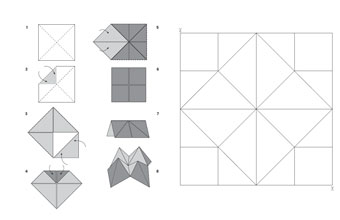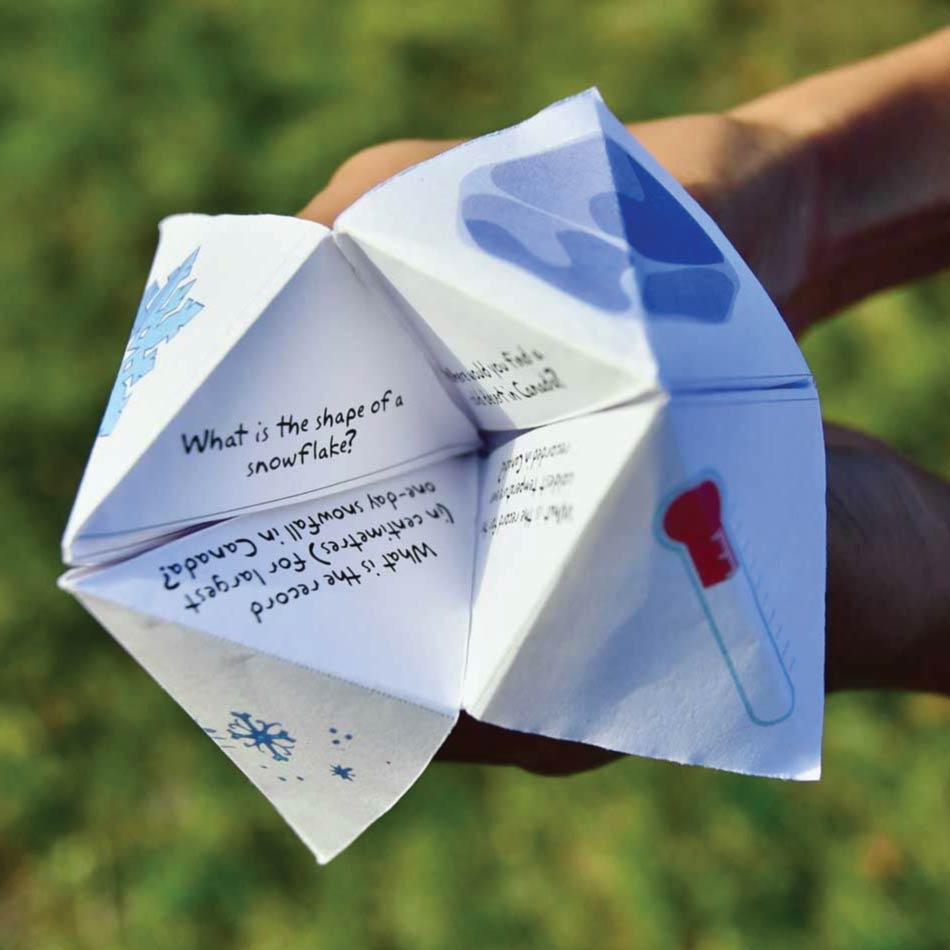Ice and Snow Fold the Facts
Make an origami finger game that reveals snowy science facts.
- All
- Things to Make
- Puzzles + Games

What you’ll need:
- Paper
- Markers, crayons, pencil crayons or paint
- Scissors
- Ruler


Activity setup:
- Start with a square piece of paper. (You can print and cut out the template on the last page, or make your own piece of square paper using scissors and a ruler.)
- Fold your paper in half vertically and make a triangle.
- Fold your paper in half again, this time in the opposite direction. When you unfold it now, it should be divided by fold marks into four small triangles, or quadrants.
- Take each corner and fold it into the centre. Do not unfold these new folds. Once all four corners have been folded into the centre, you’ll have a smaller square with four isosceles triangles on one side.
- Flip the paper over and fold each corner into the centre again. Now, you’ll have an even smaller square with four isosceles triangles, each one split into two.
- Flip the paper back to the other side, and loosen each flap a bit with your finger. Then put a thumb and your pointer finger into two flaps on one side and the other thumb and pointer finger into the two flaps on the other side. Push your thumbs and fingers together. Your paper should now be roughly mountain-shaped, with four separate peaks pushed together, sitting on your fingers and thumbs.
- Write a short ice or snow question from the next page on the inner surfaces of the peaks.
- Write the answers to the questions under the corresponding flaps.
- Draw four snow- or ice-related pictures on the outside of your paper mountain, like a snowflake, hat, mittens and a scarf. To start the game, select a picture and spell the word out loud by opening and closing the mountain for each letter.
- Use this game on your own to learn ice and snow trivia, or play it as a guessing game with a friend or family member.
- Have fun!

Snowy Science
In Canada, the winter months bring fewer hours of daylight and colder weather. Due to the tilt of the Earth, which is about 23 degrees, the Sun’s light shines on the Northern Hemisphere less directly during these months. Some scientists hypothesize that the tilt of the Earth—along with the formation of the Moon—was caused by a big collision with a Mars-sized object early in Earth’s history.
This drop in temperature causes water outside to freeze—especially small bodies of fresh water. As the temperature drops, the movement of water molecules slows down until ice forms. A very small amount of water remains on the surface of the ice and constantly melts and refreezes. When you skate on ice, like on an indoor rink or a frozen pond, the friction from your blades helps melt this top layer—so you’re actually skating on a very thin layer of water!
Water also does something special when it freezes: It expands and gets less dense. Because ice is less dense than water, it floats on the surface. In lakes and ponds, this phenomenon allows fish and other wildlife to continue swimming beneath the ice over the winter.

Ice and Snow Trivia
Q: What is the record (in centimetres) for largest one-day snowfall in Canada?
A: 145 cm of snow fell at Tahtsa Lake, B.C., on Feb. 11, 1999.
Q: At what temperature is water most dense?
A: About 4°C—it actually gets less dense as it drops to 0°C.
Q: At what temperature does seawater freeze?
A: About -2°C. Rising temperatures associated with climate change have resulted in less Arctic sea ice.
Q: What is the shape of a snowflake?
A: Snowflakes are hexagonal.
Q: Where would you find a cold desert in Canada?
A: In the Arctic. Due to their low humidity and precipitation, some areas of the Arctic are known as “polar deserts.”
Q: What is graupel?
A: Small snow pellets, also known as soft hail.
Q: When is Earth closest to the Sun: winter or summer?
A: Winter. The Earth’s orbit around the Sun is elliptical (oval-shaped). Winter is colder than summer due to the tilt of the Earth, not Earth’s position around the Sun.
Q: What is the record for the coldest temperature ever recorded in Canada?
A: -63°C, a record set in Snag, Yukon, on February 3, 1947.